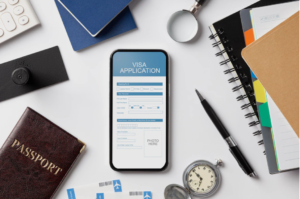Tarjeta Verde para Inmigrantes con Preferencia Familiar
La familia lo es todo, y para muchos, el sueño de reunirse con sus seres queridos en Estados Unidos es uno de los objetivos más importantes de su proceso migratorio. El programa de Tarjeta Verde con Preferencia Familiar ofrece una vía legal para que ciertos familiares de ciudadanos estadounidenses y residentes permanentes legales residan permanentemente en el país.
En Immigration Universe Attorneys , entendemos que cada historia familiar es única. Liderados por la abogada Ileana Rivera , nuestra misión es guiarle en cada paso de su proceso migratorio con honestidad, compasión y claridad.
¿Qué es una Tarjeta Verde de Preferencia Familiar?
La Tarjeta Verde de Preferencia Familiar es una categoría de visa de inmigrante que permite a ciertos familiares de ciudadanos estadounidenses o residentes permanentes obtener la residencia permanente legal. Se diferencia de la Tarjeta Verde para Familiares Inmediatos porque aplica a familiares extendidos y está sujeta a un límite anual de solicitudes.
Esto significa que no todas las peticiones se procesan de inmediato. Los solicitantes se colocan en una cola según su fecha de prioridad , la cual determina cuándo su número de visa está disponible según el Boletín de Visas publicado por el Departamento de Estado de EE. UU.
¿Quién califica para una Tarjeta Verde de Preferencia Familiar?
La elegibilidad depende de su parentesco con un ciudadano estadounidense o residente permanente legal. A continuación, se presentan las principales categorías de preferencia reconocidas por la ley de inmigración estadounidense.
| Categoría | Relación elegible | ¿Quién puede aplicar? |
| F1 | Hijos e hijas solteros (de 21 años o más) de ciudadanos estadounidenses | Peticiones de ciudadanos estadounidenses para hijos adultos |
| F2A | Cónyuges e hijos solteros (menores de 21 años) de residentes permanentes legales | Peticiones de titulares de tarjetas verdes para cónyuge o hijos |
| F2B | Hijos e hijas solteros (de 21 años o más) de residentes permanentes legales | Peticiones de titulares de tarjetas verdes para hijos adultos |
| F3 | Hijos e hijas casados de ciudadanos estadounidenses | Peticiones de ciudadanos estadounidenses para hijos casados y familiares |
| F4 | Hermanos y hermanas de ciudadanos estadounidenses (si el solicitante tiene 21 años o más) | Peticiones de ciudadanía estadounidense para hermanos |
Cada categoría tiene diferentes tiempos de procesamiento y el número de visas disponibles al año es limitado. Comprender dónde se ajusta su caso es fundamental para establecer expectativas realistas.
¿Cómo funcionan las fechas de prioridad?
Cada vez que se presenta una petición familiar mediante el Formulario I-130 , el USCIS asigna una fecha de prioridad . Esta fecha representa su lugar en la fila. Cuando su fecha de prioridad esté vigente según el Boletín de Visas, su caso puede avanzar para su procesamiento consular o ajuste de estatus .
Debido a que Estados Unidos limita el número de visas por categoría y país, los tiempos de espera pueden variar drásticamente: desde meses hasta más de una década en ciertos casos, especialmente para ciudadanos de México, Filipinas, India o China.
Ajuste de estatus vs. trámite consular
Hay dos formas principales de obtener su Tarjeta Verde una vez que su fecha de prioridad esté vigente.
Ajuste de Estatus (AOS). Si ya se encuentra en Estados Unidos con una visa válida, podría ser elegible para solicitar el AOS mediante el Formulario I-485 sin salir del país. Este proceso le permite permanecer en EE. UU. mientras su caso está pendiente.
Trámite consular: Si reside fuera de EE. UU., deberá completar su entrevista de inmigración en un consulado estadounidense en su país de origen. Tras la aprobación, podrá viajar a Estados Unidos como residente permanente.
| Tipo de proceso | Donde sucede | Beneficio clave | Marco de tiempo típico |
| Ajuste de estatus | Dentro de los EE.UU. | No es necesario viajar al extranjero | 8–14 meses |
| Trámite consular | En el extranjero | Más sencillo para solicitantes fuera de EE. UU. | 12–18 meses |
Un abogado de inmigración con experiencia determinará qué proceso se adapta mejor a sus circunstancias y le ayudará a preparar la documentación necesaria para evitar retrasos.
Errores comunes que retrasan las solicitudes de la tarjeta verde familiar
Incluso pequeños errores pueden causar grandes contratiempos en los casos de inmigración. Algunos de los errores más frecuentes incluyen:
- Presentar formularios incompletos o incorrectos.
- No incluir traducciones certificadas o documentos de respaldo requeridos.
- Malentendido sobre la elegibilidad para la categoría familiar correcta.
- Mudarse sin actualizar su dirección postal con USCIS.
- Responder tarde a una solicitud de evidencia (RFE) .
Trabajar con un abogado calificado garantiza que cada detalle de su petición se maneje correctamente y que reciba orientación profesional durante todo su caso.
Cómo pueden ayudarle los abogados de Immigration Universe
En Immigration Universe Attorneys , hacemos más que simplemente presentar documentos. Nuestro equipo ayuda a las familias a reunificarse brindándoles:
- Una revisión completa de su historial de inmigración y elegibilidad.
- Preparación estratégica de su petición para reducir retrasos.
- Comunicación continua para que siempre sepas el estado de tu caso.
- Representación legal ante USCIS y, de ser necesario, en la corte de inmigración.
La abogada Ileana Rivera , miembro de la Asociación Americana de Abogados de Inmigración (AILA) , tiene más de diez años de experiencia en el manejo de peticiones familiares, perdones y solicitudes de ajuste de estatus.
Nuestra firma sirve con orgullo a familias en Orlando, Kissimmee, Winter Park y áreas circundantes.
👉Obtenga más información sobre nuestro apoyo legal para familias aquí: Servicios de Inmigración .
Programe su consulta confidencial
Deje que nuestro equipo le ayude a comprender sus derechos y opciones legales.
Teléfono: +1 (407) 818-1244
Correo electrónico: service@immigration-uni.com Dirección: 7901 Kingspointe Blvd, Ste. 8, Orlando, FL 32819 WhatsApp: +1 (407) 720-8983
Preguntas frecuentes (FAQ)
- ¿Quién califica para una Tarjeta Verde de Preferencia Familiar? Los ciudadanos estadounidenses y los residentes permanentes legales pueden solicitar la residencia permanente para ciertos familiares, como hijos adultos, hijos casados o hermanos, bajo el sistema de Preferencia Familiar.
- ¿Cuánto tiempo se tarda en recibir una Tarjeta Verde con Preferencia Familiar? El tiempo de procesamiento depende de la categoría de visa y del país de origen del solicitante. Algunos casos se procesan en meses, mientras que otros pueden tardar varios años debido a los límites anuales.
- ¿Puedo solicitarlo mientras resido en EE. UU.? Sí. Si reside legalmente en EE. UU., puede solicitar un Ajuste de Estatus . Si se encuentra en el extranjero, deberá completar el trámite consular a través del consulado estadounidense más cercano.
- ¿Qué sucede si mi peticionario se convierte en ciudadano estadounidense durante el proceso? Si un residente permanente legal que presentó la petición en su nombre se convierte en ciudadano estadounidense, su caso podría avanzar a una categoría más rápida. Su abogado puede solicitar la reclasificación.
- ¿Necesito un abogado de inmigración para este proceso? Si bien no es obligatorio, contar con un abogado mejora considerablemente la precisión, reduce el riesgo de rechazo y garantiza que su solicitud cumpla con la legislación migratoria vigente.











